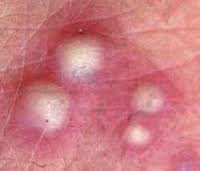Pustules
Pustules are an elevated lesion on the skin that is filled with pus. It is simply the medical term for pimples or zits. They are visible several days after papules have formed, when the white blood cells rise to the surface of the skin. Like cystic acne, pimples can be large and painful. Proper care should be taken to allow the pimples to heal properly.
- They are considered
to be a moderate form of acne that presents itself as middle-sized bumps on the
face. These bumps have a noticeably white or yellow dot in the center and are
surrounded by inflammation. While inflamed, it is generally painless and
do not contain a great deal of bacteria.

- The pus is part of an infection of the pore cavity
which the body is trying to push out. If left to run its natural course, a
small opening grows for the skin to push the infection out. Eventually, it bursts and the fluid contained inside, including the infected fluid is
released from the body. The build-up of dead skin cells, which most likely
caused the blockage, and built up sebum are also pushed out. All that is left behind
is a tiny hole which the body soon closes and starts to heal.
- Pimples are typically found on the face and neck,
though they can appear anywhere on the body. There are literally dozens of skin
conditions and other ailments that can cause pimples to appear, though some
are more common than others.
Causes of pustules
It is caused by the
accumulation of pus at the surface of the skin. Although pus formation
typically indicates a bacterial infection, pimples are most commonly seen in
acne, which is caused by the clogging of pores in the skin and the subsequent
accumulation of oil and bacteria.
The hormones that are
active during puberty also trigger your sebaceous glands to produce more sebum.
The hormones with the greatest effect on the oil glands are the androgens, the
male hormones. Both men and women have androgens, but men have more.
Formation of pustular acne
In pustular acne, the pore is
blocked with sweat, oil or dead skin cells, and bacteria start to infect and feed
on the excess secretions. The bacteria's secretions irritate the walls of the
pore so that it becomes red and swells into a pimple.
Features
- These pimples or zits, are generally dome shaped,
- Pus filled lesions comprising a mixture of white blood cells, bacteria and dead skin cells.
- It usually forms over sebaceous follicles with a hair in its center and heal without progressing into cysts.
- Pimples seldom leaves scar.
Prevention
- The first step to take is to change your diet by excluding foods which are known to cause or worsen acne.
- Reduce your intake of oily, greasy food as well as sugary drinks and snacks.
- Take a break off milk and milk products to see if your acne gets better without them.
- Because stress can also cause acne, try to relax and avoid stressful situations.
- Avoid compulsively touching your face or picking your acne lesions.
- Wash your face at least twice daily but only use mild and gentle soaps and cleansers.
- Do not scrub your face trying to remove your pimples. This will only irritate the skin and aggravate the acne lesions already present.
- Use oil-free moisturizers and introduce
lotions, cleansers and creams that contain salicylic acid
Treatment
Because pustular acne can
be very painful, both physically and emotionally, it is very important to find
safe and effective ways of implementing a pustule treatment program into your
everyday routine. There are many products available on the market to choose
from. Find the right products or treatment program for your particular
condition.
Tags
papules, cystic acne, moderate acne, acne, scars, salicylic acid, treatment
Irresistible Acne Remedies. This free newsletter is delivered monthly, straight to your INBOX. It covers all new pages since the last issue. Sign up here...


New! Comments
Have your say about what you just read! Leave me a comment in the box below.